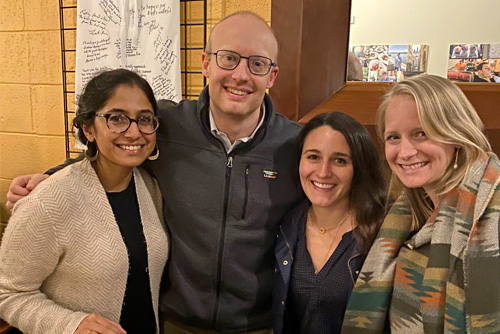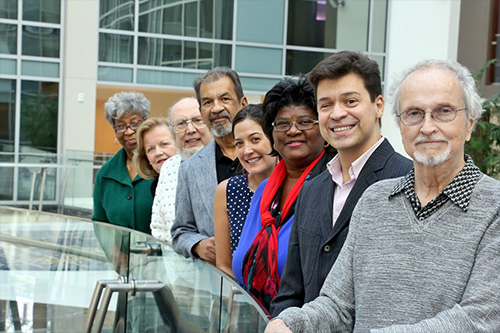Get an inside look at research projects supported by Duke CTSI as they make the journey from bench to bedside.
How does a scientific idea become a reality? How does a research team navigate scientific, funding, and regulatory challenges to make a difference in the lives of patients and communities?
This series of Idea to Impact Case Studies provides a window into successful projects supported by Duke CTSI, revealing both their translational paths and the benefits they are yielding to the healthcare world.
Each case study includes:
-
Project overview
-
Timeline of funding and commercialization milestones
-
Summary of translational impact and benefits
-
Resources used
Individually and collectively, these case studies aim to:
-
Provide a contextualized lens on CTSA services by conveying their use within specific studies and research projects.
-
Provide a clear summative focus addressing translational research outcomes and impacts.
-
Permit understanding of inhibitors or challenges in translational research process that CTSA may be situated to address.
-
Disseminate facilitators or best practices for improving translational research.
Maternal Morbidity at Duke and UNC: A Multicenter Examination of Risk Factors
A research study led by Marie-Louise Meng, MD, co-principal investigator for Duke University, and Johanna Quist-Nelson, MD, co-principal investigator for the University of North Carolina at Chapel Hill.
Over the past 30 years, maternal morbidity and mortality rates in the United States have more than doubled. Rates now exceed other high-income nations, and there are severe disparities in maternal mortality. This research determines the severe maternal morbidity rate (SMM) at Duke and UNC and examines racial and ethnic disparities within those morbidity events.
This case study discusses research methods and results and explores the challenges the researchers faced, as well as the strategies they used to overcome those obstacles. For non-research audiences, it offers an accessible way to understand the science and its benefits to society.
Paving the Pathway: YOJO, An Online Platform to Facilitate Persistence and Sustainability in Educational and Professional Development Programs
Pathway programs – which are programs that help someone move from one stage to the next in their educational career – operate in silos, making it difficult for learners to chart and persist on a path that supports their long-term career goals.
The Center for Pathway Programs is developing YOJO (short for “Your Journey”), an online platform that connects pathway programs, simplifies the application process, tracks participants, enhances evaluation, and ultimately promotes persistence.
New Option for Treatment of Uterine Fibroids: Engineering Smart Therapeutics
Uterine fibroids are common reproductive-age tumors. More than 80% of Black women and nearly 70% of White women have fibroids by age 50. Currently available interventions are either expensive, difficult to access, or have significant systemic side effects.
Thanks to a collaborative partnership between Duke and North Carolina Central University (NCCU) researchers developed and tested a protective carrier for drug therapeutics to enable a direct local injection into the uterine fibroid. This presents a minimally invasive treatment option for women suffering from uterine fibroids.
Collaboration Across Campuses: The NCCU Clinical Research Sciences Program
The lack of a diverse workforce in clinical research negatively impacts health outcomes and equity in clinical trials, healthcare, and medical practices.
The Clinical Research Sciences Program (CRSP) leveraged the partnership between North Carolina Central University and Duke University to create an environment for producing a highly trained and diverse workforce in clinical research.
Oxysterols for Treatment of Perinatal Brain Injury: A First-In-Class Therapy to Prevent Cerebral Palsy in Premature Infants
Premature infants are at higher risk for brain injuries that can cause lifelong impairments, such as cerebral palsy. This research is developing the first treatment to reverse the damage of these brain injuries, using a molecule found in human breast milk.
Principal Investigator: Eric Benner, MD, PhD, Duke University School of Medicine, Department of Pediatrics
The ADAPTABLE Study: Aspirin Dosing: A Patient-Centric Trial Assessing Benefits and Long-Term Effectiveness
Aspirin is a mainstay therapy for patients with atherosclerotic cardiovascular disease (ASCVD), but there are unanswered questions about the best dosage. ADAPTABLE studied the effectiveness and safety of the two most common aspirin doses, and also served as a demonstration project for clinical trials in the Patient-Centered Outcomes Research network (PCORnet), enrolling more than 15,000 participants across multiple sites.
Principal Investigators: Adrian Hernandez, MD, vice dean and executive director, Duke Clinical Research Institute; W. Schuyler Jones, MD, assistant professor of medicine, Duke University School of Medicine
Biopsychosocial Determinants of Pain in Sickle Cell Disease: A Study of the Contributors to Severe Pain, Toward Better Management
Many people with sickle cell disease frequently experience severe pain, and the contributing factors to that symptom have not been fully understood. This research project identified a biomarker that is significantly associated with pain in people with sickle cell disease, offering a new exploratory direction for research.
Principal Investigator: Mitchell Knisely, PhD, RN, Duke University School of Nursing
About the Translational Science Benefits Model
These case studies have been produced using the Translational Science Benefits Model (TSBM) developed at Washington University. Public health and clinical scientists use this model to demonstrate the impact of their work in the real world.
Citation: Institute of Clinical & Translational Sciences at Washington University in St. Louis. Translational Science Benefits Model website. https://translationalsciencebenefits.wustl.edu. Published February 1, 2019. Accessed December 20, 2020.






